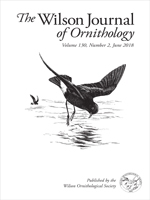Wetlands under moist-soil management are managed using disturbance and water regimes to enhance vegetative production during the growing season and flooded in the fall to accommodate waterfowl; however, little research has investigated the use of such wetlands by secretive marsh birds. Our objective was to determine patterns of habitat use by bitterns (Ardeidae) and rails (Rallidae), “secretive marsh birds,” in relation to habitat structure within and among moist-soil wetlands during spring and fall migration in Kansas. We used call-playback (spring) and flush counts (fall) to survey birds. Of our target species, only American Bittern (Botaurus lentiginosus), Least Bittern (Ixobrychus exilis), Virginia Rail (Rallus limicola), and Sora (Porzana carolina) were detected. Abundances varied markedly between years of our study (2014 and 2015), perhaps because of annual variation in precipitation or drawdown timings. In spring, Sora were found in wetland units with relatively tall Polygonum. No other significant habitat-use patterns were found for other species among wetland units in spring or for any species during fall migration. At the microhabitat scale (within wetlands) during fall, American Bittern and Sora were detected at points of less bare ground, lower grass cover, and greater water cover and depth than systematic sampling points along survey transects. American Bitterns were detected in microhabitats with higher cattail (Typha spp.) cover and height than Sora locations or systematic sampling points along survey transects. Sora were detected in microhabitats with greater Polygonum spp. cover and height and deeper water than American Bittern locations or habitat sampling points along transects. Among years and within wetlands, marsh birds in moist-soil managed wetlands were associated with thick standing vegetation and water, which are likely affected by drawdown timing.
How to translate text using browser tools
1 June 2018
Habitat use by secretive marsh birds during spring and fall migration in moist-soil wetlands in Kansas
Eric D. Wilson,
William E. Jensen,
Richard Schultheis
ACCESS THE FULL ARTICLE

The Wilson Journal of Ornithology
Vol. 130 • No. 2
June 2018
Vol. 130 • No. 2
June 2018
American Bittern
moist-soil management
secretive marsh birds
Sora
Wetlands




